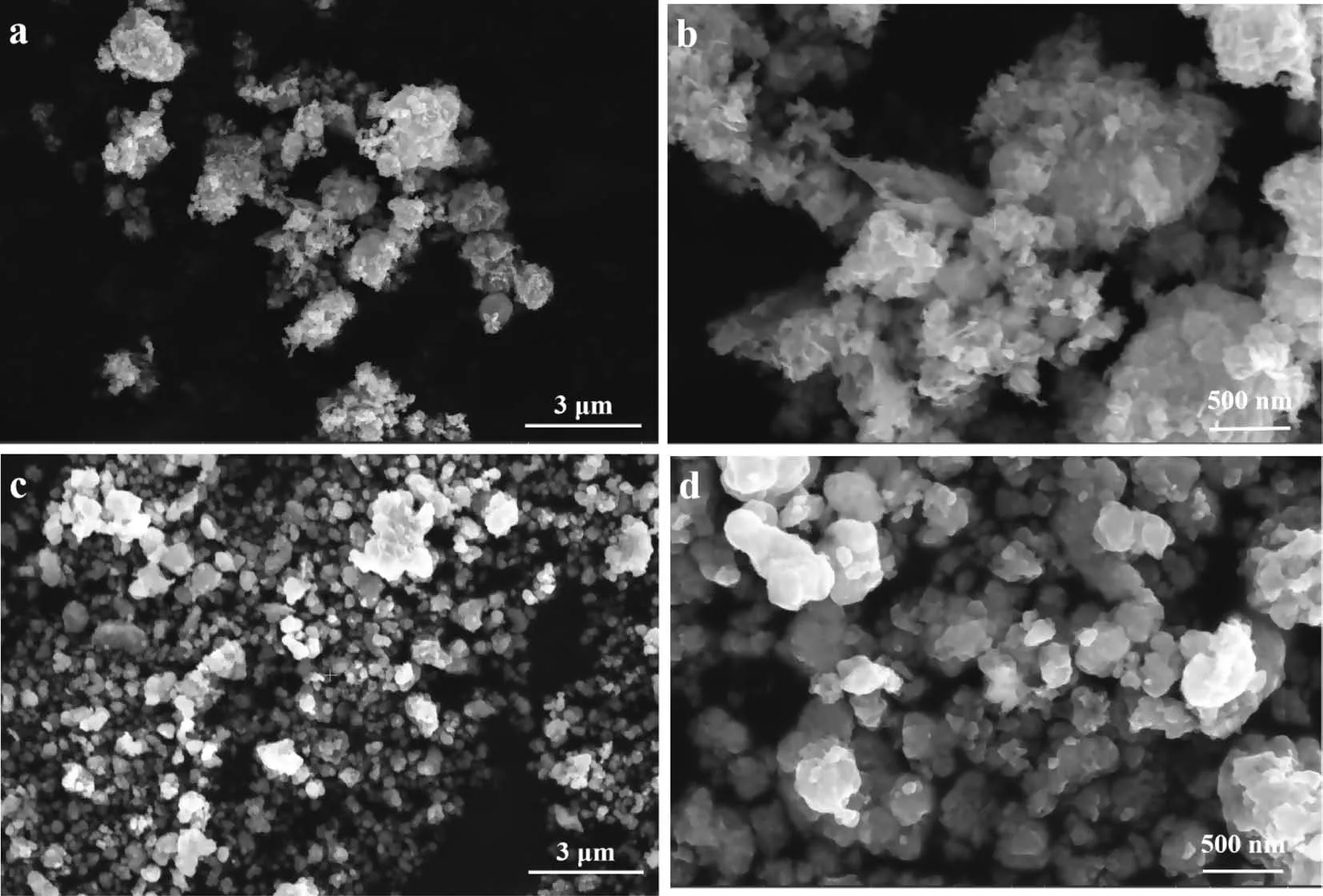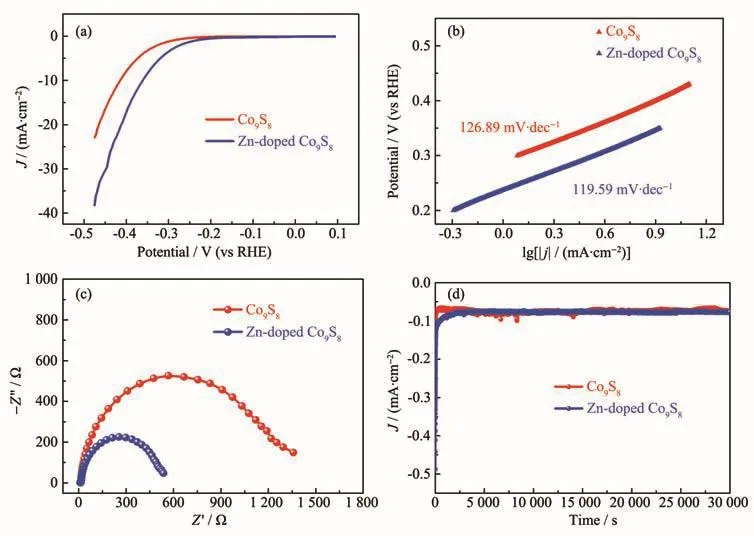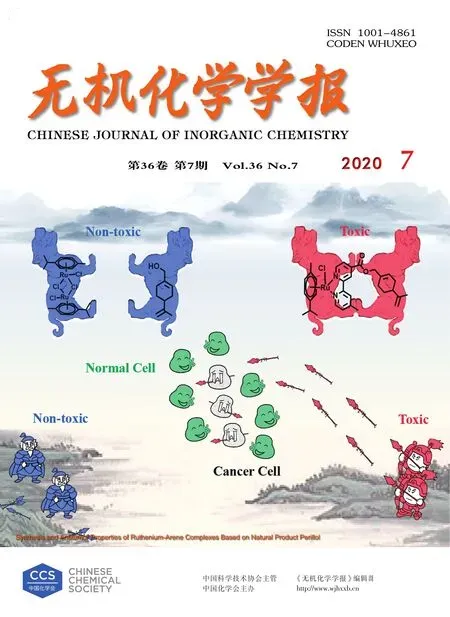Zn掺杂Co9S8纳米材料的制备及其在超级电容器和电催化析氢中的应用
于海峰 王 芳*,,2 冯 婷 刘少兵 马福贵 杨孟新 梁鹏举*,
(1洛阳理工学院环境工程与化学学院,洛阳 471023)
(2北京化工大学有机无机复合材料国家重点实验室,北京 100029)
(3塔里木大学生命科学学院,阿拉尔 843300)
0 Introduction
With development of the economy and improvement in living standards,there is a need for a new energy source that is stable in performance,clean,cheap,and highly efficient to supersede traditional fossil fuel energy sources.Among all kinds of new energy sources,hydrogen energy stands out as its high mass-specific energy density and zero pollution[1-2].At present,electrochemical water splitting is considered to be the most effective and friendly hydrogen production technology.Hydrogen evolution reaction(HER)is an important semi-reaction in electrochemical water splitting[3-4].However,high overpotential and slow kinetics of HER greatly reduce the hydrogen production efficiency,so it is necessary to develop effective electrocatalysts.Besides,a large number of hydrogen energy also needs an efficient energy storage devices,such as supercapacitors[5-8]and batteries[9-10].Supercapacitors have a number of advantages,for instance long cycle life,negligible pollutant generation,fast charge and discharge rates,excellent stability,low cost,and high energy density[11-14].
At present,low energy density and instability structural impedes practical application of energy storage devices.In order to improve the performance of energy storage devices,it is essential to design and synthesize electrode materials which possess high electric capacity[15].There are variety of electrode materials used in energy storage devices,for example MnO2[16-18],MnS[19],MoS2[20-21],MoSe2[22],Co3O4[23-24],NiCo2O4[25]and NiCo2S4[26].In particular,Co9S8has been widely used as a potential material for HER[27-30]and in supercapacitors due to its microstructure(cubic,belonging to the Fm3m space group[31]).Its structure gives it a high specific capacitance,high electrical conductivity,mixed valence,and metallic behavior.It can be fabricated as a variety of nanostructures,including nanoparticles,nanorods,nanosheets and microspheres[32-34].
At present,researchers are focusing on synthesizing new nanostructures based on combining Co9S8with metals or other materials,in order to increase specific surface area,active site density,shorten charge transfer pathways,and enhance specific capacitance.These strategies can be roughly divided into three categories:firstly,Co9S8can be combined with graphene[35],carbon cloth[36-37],carbon nanofibers[38]or nickel foam[39-40],materials with excellent electrochemical properties.Secondly,metal organic frameworks(MOFs)can be used as precursors or sacrificial structures to form new porous nanostructures.MOFs have the advantages of adjustable pore size,high porosity,and high specific surface area.An example of this is from Niu et al.,who fabricated a novel macroporous nanostructure using N-doped hollow carbon spheres and MOF-derived Co9S8embedded in graphene.The resulting material exhibited a high volumetric capacitance and high surface area,and provided a nanostructure environment for electrons and ions in the electrolyte[41].Thirdly,doping Co9S8with different metal ions is generally considered as a simple and effective method[42-43].
Herein,we report a simple strategy using anin situsolvothermal growth method to synthesize Zn-doped Co9S8nanoparticles.Experimental results show that the zinc dopant can improve electrocatalytic performance relative to pure Co9S8.Hydrogen evolution reaction testing shows that this material exhibited high current density,low onset potential,and long-term stability.Also,Zn-doped Co9S8exhibited excellent performance in supercapacitors,with a specific capacitance of 235.48 F·g−1at 1 A·g−1.This indicates that using doping in the synthesis process can play a role in improving the performance of materials.
1 Experimental
1.1 Materials
Zinc acetate dihydrate (Zn(CH3COO)2·2H2O,99%),cobaltacetate tetrahydrate (Co(CH3COO)2·4H2O,99.5%)and potassium hydroxide(KOH,85%)were purchased from China Pharmaceutical Chemicals Co.,Ltd.Thiourea and ethylene glycol were obtained from Tianjin Zhiyuan Chemical Reagent Co.,Ltd.All regents were used without further purification.Water resistivity used in all electrochemical measurements was 18.25 MΩ·cm.
1.1.1 Synthesis of Co9S8Nanoparticles
Co9S8Nanoparticles were synthesized viain situsolvothermal growth.In a typical procedure,1.743 7 g cobalt acetate tetrahydrate and 0.532 8 g thiourea were dissolved in 20 mL ethylene glycol solvent sequentially.This solution was magnetically stirred for 30 min,then transferred into a Teflon-lined stainless-steel autoclave and held at 200℃for 48 h,then cooled to room temperature.The resultant mixture was centrifuged(5 000 r·min−1,20 min)and the precipitate was washed with ethanol and distilled water several times.The isolated Co9S8nanoparticles were then vacuum dried at 60℃for 3 h.
1.1.2 Synthesis of Zn-doped Co9S8Nanoparticles
The Zn-doped Co9S8Nanoparticles were prepared with the same procedure described above,but with the addition of 0.015 3 g zinc acetate dihydrate added to the initial solution.
1.2 Characterization
The crystallographic structure,phase purity of the nanoparticle samples were determined by X-ray powder diffraction(XRD,Bruker AXS D8 Advance)using a CuKαsource(λ=0.154 06 nm)with a filament current of 40 mA and a tube voltage of 40 kV(2θ=20°~70°).Microstructure and morphology were characterized using scanning electron microscopy(SEM,FEI Quanta FEG 250).The specific surface areas of the samples were measured by Brunauer-Emmett-Teller(BET)N2gas adsorption analysis.
1.3 Electrochemical measurements
HER performance tests were carried out a typical three-electrode system,with the preparation of a working electrode carried out using a common method described previously[44].The reference electrode was calibrated with respect to a reversible hydrogen electrode and all potentials reported in this work are expressed vs RHE.Linear sweep voltammetry(LSV)was conducted using a sweep rate of 5 mV·s−1at voltages of−0.475 to 0.094 V(vs RHE).Electrochemical impedance spectroscopy(EIS)measurements were performed in the frequency range 0.1 Hz~100 kHz at an amplitude of−0.276 V.All tests were performed with current-resistance(IR)compensation.
Supercapacitor performance tests were also carried out in a three-electrode system,with a 1 mol·L−1KOH electrolyte,with the Ni foam loaded with active catalysts used as the working electrode.The geometric area of nickel foam was about 1 cm2.The preparation process for the active working electrode was the same as one reported previously[45].CV curves were obtained at 5 mV·s−1,from 0 to 0.6 V.EIS measurements were performed in the frequency range of 0.1 Hz~100 kHz at an amplitude of 0.45 V.The specific capacitance of electrode material is calculated by the equation[46]:

whereCis the specific capacitance(F·g−1),Iis the discharge current(A),Δtis the discharge time(s),ΔVis the charge-discharge voltage window(V)andmis the mass of active material(g).
The area capacitance values were obtained from the following equation[47]:

whereCais the area capacitance(F·cm−2)andsis the surface area of the electrode.
2 Results and discussion
It can be seen from Fig.1 that pure Co9S8appears to be highly agglomerated.Zn doping of Co9S8induces the formation of smaller,more distinctly separated nanoparticles,which suggests that zinc plays a role in determining the morphology of the nanoparticles.The XRD patterns of pure Co9S8and Zn-doped Co9S8(Fig.2(a))both exhibited clear diffraction peaks and high crystallinity.Peaks at 2θof 29.08°,31.12°,44.59°,47.62°,52.32°,54.2°,55.51°can be ascribed to the(311),(222),(422),(511),(440),(531),(600)planes of Co9S8.The major diffraction peaks are in good agreement with cubic Co9S8(PDF No.02-1459).Peak position and intensity did not change due to zinc doping,and no detectable diffraction peak from zinc was found in Zn-doped Co9S8.This indicates that zinc may had been successfully doped into the crystal lattice of Co9S8[48].
Measurement of the N2adsorption-desorption isotherm and pore size distribution was used to further in-vestigate the structure and pore characteristics of the Zn-doped Co9S8and Co9S8(Fig.2(b~d)).Hysteresis loop appeared in isotherms of both materials.BET analysis shows the surface area of the Zn-doped Co9S8was 23 m2·g−1,with the pore size mainly distributed in 20 nm.Meanwhile,the surface area of the Co9S8was 20 m2·g−1,with the pore size was mainly 26 nm.These results indicate that the low-content Zn doped has a weak effect on the surface area and pore size of Co9S8.

Fig.1 SEM images of(a,b)Co9S8and(c,d)Zn-doped Co9S8at different magnifications

Fig.2 (a)XRD patterns,and(b)nitrogen adsorption-desorption isotherms of Co9S8and Zn-doped Co9S8;(c,d)Barret-Joyner-Halenda(BJH)pore size distribution of Co9S8and Zn-doped Co9S8
The chemical structures and the surface compositions of Zn-doped Co9S8was further investigated by high-resolution XPS.The survey spectrum(Fig.3(a))can clearly confirm the presence of Co,S,Zn,C and O elements in the composites.The XPS spectrum of Co2pis shown in Fig.3(b).There are six peaks located at 780,782,786.1,796.7,798.15 and 803.6 eV,which were assigned to Co3+2p1/2,Co2+2p1/2,satellite peak,Co3+2p3/2,Co2+2p3/2,satellite peak,respectively[49-50].The high-resolution S2pXPS spectrum(Fig.3(c))shows five binding energies.The peaks at 162.05 and 163.2 eV can be attributed to the S2p3/2and S2p1/2binding energies of Co9S8,respectively[51-52].The peak at 165.3 eV was assigned to the Co-S,which may derive from the interfaces of Co9S8.In addition,the peaks at 169.05 and 170.25 eV are assigned to C-SO2-C and C-SO3-C,respectively[53-54].The XPS spectrum of Zn2p can be shown in Fig.3(d).The weary peaks at about 1 022.35 and 1 044.5 eV were assigned to Zn2p3/2and Zn2p1/2,respectively.The faint peaks showed that the doping amount of zinc was very small,which can be proved by the atomic percentage.Through XPS test,the atomic fraction were 4.82%(S2p),72.58%(C1s),17.54%(O1s),4.52%(Co2p)and 0.55%(Zn2p),indicating zinc was successfully doped into Co9S8.
Next,the performance of the two as-prepared samples to catalyze hydrogen evolution reactions(HER)was evaluated.Fig.4(a)shows the polarization curves of the catalysts.The Zn-doped Co9S8nanoparticles exhibited a low onset potential than Co9S8,and the potential of Zn-doped Co9S8was−361 mV at 10 mA·cm−2,smaller than without zinc doping(−414 mV).Fig.4(b)shows the corresponding Tafel plots to illustrate the HER kinetics.As expected,Zn-doped Co9S8demonstrates a lower Tafel slope of 119.59 mV·dec−1compared to Co9S8(126.89 mV·dec−1).A smaller Tafel slope indicates a higher HER speed.As shown in Fig.4(c),EIS analysis was carried out to further characterize interface reactions taking place in the system.The Nyquist plot shows that the charge transfer resistance of the Zndoped Co9S8was 536.1 Ω,significantly smaller than Co9S8(1 358 Ω).These results indicate that electron diffusion is rapid in Zn-doped Co9S8,which contributes to its higher catalytic activity.

Fig.3 XPS spectra of Zn-doped Co9S8

Fig.4 HER performance testing using Co9S8and Zn-doped Co9S8in 1 mol·L−1KOH:(a)Polarization curves at−0.475 to 0.094 V(vs RHE)at a rate of 5 mV·s−1,and(b)corresponding Tafel plots;(c)Electrochemical impedance spectroscopy at−276 mV vs RHE;(d)Time dependent current density at−176 mV vs RHE
To determine the stability of the samples in 1 mol·L−1KOH,a durability test was conducted at−176 mV vs RHE for 30 000 s continuous operation(Fig.4(d)).The periodic fluctuations of current density were due to accumulation and overflow of H2bubbles.The current density of Zn-doped Co9S8was maintained at 0.077 mA·cm−2,while the current density of Co9S8stabilized at 0.074 mA·cm−2,indicating Zn-doped Co9S8had better catalytic stability.
The above electrochemical tests demonstrated that the introduction of zinc improves the electrochemical performance of the Co9S8.This can mainly be ascribed to zinc occupying positions in the sulfide crystal structure,changing the charge state,generating more active sites,and adjusting the band gap.Previous literature has also demonstrated that doping with a second metal can activate previously inert sites,add new active centers,improve charge carrier uniformity,and enhance the reversibility of electron and charge transfer on the catalytic electrode in the HER reaction[48,55-56].
At the same time,the catalytic performance of synthetic materials in supercapacitors had been further studied.Electrochemical testing was next conducted in which the catalyst was coated on nickel foam as the working electrode,with a platinum wire as the counter electrode and Hg/HgO as the reference electrode,in 1 mol·L−1KOH.Fig.5(a)shows the CV curves of Zndoped Co9S8measured at scan rates from 5 to 45 mV·s−1.Apparently,a pair of redox peaks could be obtained at low scan rate.With increasing scan rate,the anodic and cathodic peaks moved to more positive and negative potential respectively,and the high current peak,which reveals the existence of a redox reaction and at fast scanning rate,the rates of electronic and ionic transport are sufficiently rapid.At relatively high scan rates,the anodic peak disappeared gradually,which may be ascribed to a polarization phenomenon.Fig.5(b)shown the CV curves of Zn-doped and undoped Co9S8at 5 mV·s−1.As expected,the integrated area of the CV curve of Zn-doped Co9S8was significantly larger compared to Co9S8.This indicates that the specific capacitance was increased by the introduction of zinc doping.The small charge transfer resistance indicated that rapid diffusion of electron in Zn-doped Co9S8was realized at 1 mol·L−1KOH solution(Fig.5(c)).

Fig.5 Electrochemical characterization of Co9S8and Zn-doped Co9S8electrodes in 1 mol·L−1KOH:(a)CV curves of Zn-doped Co9S8at scan rates from 5 to 45 mV·s−1;(b)CV curves of Co9S8and Zn-doped Co9S8at 5 mV·s−1;(c)EIS curve of Zn-doped Co9S8

Fig.6 Galvanostatic charge/discharge(GCD)curves of(a)Co9S8and(b)Zn-doped Co9S8at various current densities;Specific capacitance of(c)Co9S8and(d)Zn-doped Co9S8at different current densities
Fig.6(a)and(b)show the charge-discharge curves of Co9S8and Zn-doped Co9S8at a range of different current densities,which shows that the discharging time of the Zn-doped Co9S8was longer than Co9S8.Specific capacitance and area capacitance of Co9S8and Zn-doped Co9S8were also calculated using equations(1)and(2),and are plotted in Fig.6(c)and(d)at different current densities.The specific capacitance of Zn-doped Co9S8were 235.48,192.58,157.26,129.03,101.61,58.06 F·g−1,and the area capacitance were 812.4,664.4,542.5,445.12,350.56,200.3 mF·cm−2at 1,2,3,4,5,6 A·g−1,respectively.The specific capacitance of Co9S8were 92,80.66,72.99,40.4,38 36 F·g−1and the area capacitance were 239.2,209.71,189.77,105.04,98.8,93.6 mF·cm−2.It displayed that with the increase of current density,the specific capacities of all materials decrease,which can be owned to the inadequate utilization of ions from the electrolyte into the active materials.
3 Conclusions
Co9S8and Zn-doped Co9S8nanoparticles were constructed via an in situ solvothermal growth method.A series of characterization and performance tests have shown that zinc doping significantly enhanced the electrochemical performance of Co9S8,mainly embodied in better HER performance and superior stability with lower potential of−361 mV at 10 mA·cm−2,especially the highest current density was 38.26 mA·cm−2.Supercapacitors performance was also improved by zinc doping,with output of higher specific capacitance of 235.48 F·g−1and area capacitance of 812.4 mF·cm−2than undoped Co9S8(92 F·g−1,239.2 mF·cm−2)at 1 A·g−1.The main reason for the improved performance of the Zn-doped Co9S8may be that zinc enters the crystal lattice of Co9S8resulting in changing the charge state and occupying positions in the crystal structure,thus producing more active sites and enhancing conductivity.This work provides a simple method to prepare nanoparticle electrode materials with improved catalytic properties,which may provide a foundation for subsequent development of new zinc-containing electrode materials.

